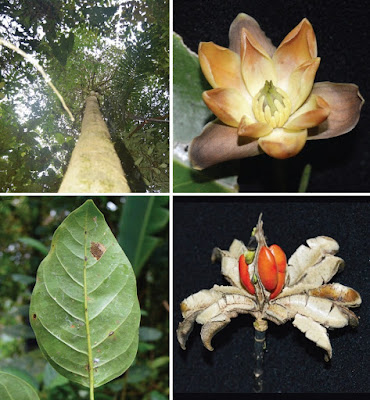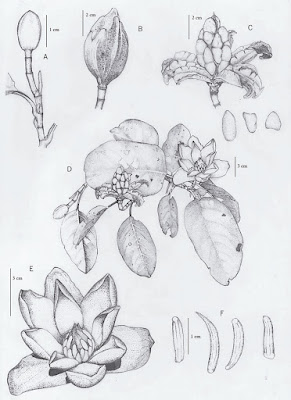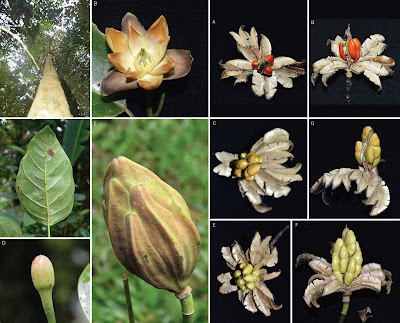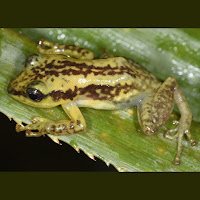[Most Recent Entries] [Calendar View]
Friday, May 4th, 2018
| Time | Event | ||||
| 9:14a | [Botany • 2018] Magnolia mercedesiarum (subsect. Talauma, Magnoliaceae) • A New Andean Species from northern Ecuador, with Insights Into Its Potential Distribution
Abstract Magnolia mercedesiarum, a new species from the eastern slopes of the Andes in northern Ecuador, is described and illustrated, and a key to Ecuadorian Magnolia (subsect. Talauma) is provided. This species differs from M. vargasiana in having broadly elliptic leaves that have an obtuse base vs. suborbicular and subcordate to cordate, glabrous stipular scars, more numerous lateral veins per side and fewer stamens. It also differs from M. llanganatensis in having leaf blades broadly elliptic vs. elliptic, longer petioles, less numerous lateral leaf veins per side, larger fruits and more numerous petals and carpels. Using MaxEnt species distribution models and IUCN threat criteria, M. mercedesiarum has a potential distribution area of less than 3307 km² and is assessed as Endangered (EN): B1 ab (i, ii, iii). The relevance of systematic vegetation sampling in the discovery of rare species is highlighted. Keywords: Magnoliids, Guacamayos; Antisana; Sumaco-Galeras; Napo; Orellana; Sucumbíos Magnolia mercedesiarum D.A.Neill, A.Vázquez & F.Arroyo, sp. nov. .... Eponymy:— The species is named in honour of two Ecuadorian women named Mercedes who have contributed to botanical science and conservation in their native country: Mercedes Asanza, professor at the Universidad Estatal Amazónica, administrative curator of the ECUAMZ herbarium at that university, and specialist in taxonomy and ecology of ferns; and Mercedes Mamallacta, a Kichwa ethnobotanist from Archidona, Napo Province, gardener, native plant propagator and inheritor and guardian of millennia of Kichwa plant lore. Ethnobotany:— No uses are recorded for the species in the type locality. However, according to informant Antonio Naranjo (Cerón & Ayala 9896, from Río Due), the plant is known as “orejas de burro” (donkey ears). It is aromatic, and leaves mixed with urine and salt are used to clean sick animals. Notes:— Magnolia mercedesiarum is the first species of Magnolia described from the eastern slopes of the Andes in northern Ecuador; it is the third confirmed species of Magnolia in Napo Province after Magnolia pastazaensis and M. “napoensis” ined. (Vázquez-García et al. 2016a), the last two at lower elevation and sympatric at Jatun Sacha Biological Station. Its occurrence in the Due River area represents the second species of Magnolia recorded from Sucumbíos Province after M. neillii in the Amazon lowlands of northeastern Ecuador (Vázquez-García et al. 2016a). J.-Antonio Vázquez-García, David A. Neill, Viacheslav Shalisko, Frank Arroyo and R Efrén Merino-Santi. 2018. Magnolia mercedesiarum (subsect. Talauma, Magnoliaceae): A New Andean Species from northern Ecuador, with Insights Into Its Potential Distribution. Phytotaxa. 346(4); 254–268. DOI: 10.11646/phytotaxa.348.4.2 researchgate.net/publication/324824414_Magnolia_mercedesiarum_a_new_Andean_species_from_northern_Ecuad | ||||
| 10:11a | [Herpetology • 2018] Guibemantis milingilingy • Stumbling Upon A New Frog Species of Guibemantis (Anura: Mantellidae) on Top of the Marojejy Massif in Northern Madagascar
We describe a new frog species of the genus Guibemantis, subgenus Pandanusicola, from Marojejy National Park in northeastern Madagascar. Guibemantis milingilingy, the new species, exhibits high genetic divergence from all other described species of Guibemantis based on DNA sequences of a fragment of the mitochondrial 16S rRNA gene. This new species inhabits Pandanus plants like the majority of other members of this subgenus, but is found at much higher elevations (2026 m a.s.l.). It differs from its closest relative, G. punctatus, by the lack of speckled or spotted dorsal patterns and by the presence of a distinctly dark tympanum. As a high-elevation species, it is likely to be a species sensitive to climate change, similar to other montane endemics in Madagascar.
Guibemantis milingilingy .... Etymology.— The specific epithet is a Malagasy word meaning ‘‘being in an uncomfortable position,’’ in reference to the precariousness of capturing specimens of this species, due to the uneven and steep substrate on which their Pandanus plants grow, which caused one of the authors to fall into such a plant with great gusto. The name is used as an invariable noun in apposition to the genus name. Available names.— No junior synonyms are available as potentially available names for any other Pandanus-dwelling species of Guibemantis. Molly C. Bletz, Mark D. Scherz, Andolalao Rakotoarison, Richard M. Lehtinen, Frank Glaw and Miguel Vences. 2018. Stumbling Upon A New Frog Species of Guibemantis (Anura: Mantellidae) on Top of the Marojejy Massif in Northern Madagascar. Copeia. 106(2); 255-263. DOI: 10.1643/CH-17-655 | ||||
| 10:45a | [Entomology • 2018] Review of the Poecilimon (Poecilimon) zonatus Species Group (Orthoptera: Phaneropterinae) and Description of New Species (Poecilimon (Poecilimon) salmani & P. (P) azizsancar) from Turkey with Data on Bioacoustics and Morphology
Abstract The aim of this study is to conduct a detailed taxonomic revision of the Poecilimon (Poecilimon) zonatus species-group (Orthoptera: Phaneropterinae) using both morphology and bioacoustics. Two new species (Poecilimon (Poecilimon) salmani, P. (P) azizsancar) and one new subspecies (P. (P) zonatus datca) are described. Based on the data, we conclude that the species complex can be separated into two subgroups (P. tauricola and P. zonatus). Within the P. zonatus subgroup, song structures indicate P. variicercis as basal branch since producing two syllable types is possibly a derived character. From both, from bioacoustics and morphology, it is concluded that the relationships between species of the group are as follows: P. tauricola subgroup (P. tauricola + P. azizsancar) + P. zonatus subgroup (P. variicercis + (P. varicornis + (P. zonatus zonatus + P. zonatus datca)) + (P. salmani + P. vodnensis)))). Except for two species (P. vodnensis and P. varicornis), the other species of the group are all distributed in Anatolia. P. vodnensis is known only from Macedonia, whereas, P. varicornis has been recorded only from Syria and Lebanon. We assume that the group originated from an Anatolian ancestral stock and expanded its distribution to the Balkans through Taurus Way and Dardanelles. Other ancestral populations may have also spread in the north-south directions through the appropriate steppe corridors in the Anatolian Diagonal Mountains and in its vicinity. Keywords: Orthoptera, Tettigoniidae, Phaneropterinae, Poecilimon, P. zonatus zonatus, P. varicornis, P. variicercis, P. vodnensis, P. salmani sp. n., P. zonatus datca ssp. n., P. tauricola, P. azizsancar sp. n., Turkey, Anatolia, Macedonia, bioacoustics, biogeography Hasan Sevgili, Deniz Şirin, Klaus-Gerhard Heller and Michèle Lemonnier-Darcemont. 2018. Review of the Poecilimon (Poecilimon) zonatus Species Group and Description of New Species from Turkey with Data on Bioacoustics and Morphology (Orthoptera: Phaneropterinae). Zootaxa. 4417(1); 1–62. DOI: 10.11646/zootaxa.4417.1.1 |
| << Previous Day |
2018/05/04 [Calendar] |
Next Day >> |










